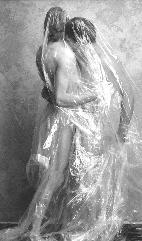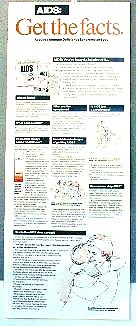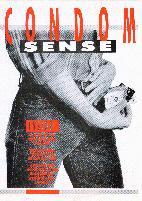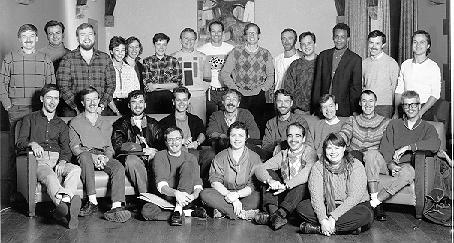|
Promiscuous |
|
Safe(r) sex promo (Mid-'80s variety)
Life in latex:
Info overload:
Gung-ho good times:
|
As Cindy Patton would later write, the "camp counsellor" tack treated gay men as if their "highly codified & ritualistic culture was lacking in norms & moral values," as if we had to be taught "intimacy."
1986
May through December
- "And I've seen her done up
and looking her very grandest, reach into a small- feathered evening bag, take out an antique cigarette case with an M in brilliants on it and offer a surprised young queen a condom.
"Something for the weekend, sir, she said, stopping him just as he was about to leave with another young man -- you see she'd noticed that they hadn't talked before going off together, they'd just started kissing and were going to drag each other home without discussing anything, and they were young, really young, eighteen.
"Madame's was one of the very first places to have condoms for free. I can't keep on fishing in this bag, she said, and then she had a holy water stoup put up by the door, and filled it with them, you just took some on the way out."
Neil Bartlett, on Madame (later Mother), in
Ready to Catch Him Should He Fall
In May I checked Toronto baths and bars to see which ones had condoms. All the baths did but The Romans, its straight owner long wary of admitting what might go on in his premises. The Barracks and The Club gave them out free. Few had anything like Madame's holy water stoup; some later would. Chaps sold rubbers at three for $2; The Toolbox offered three for $1 and, for those wary of asking over the counter, also had a coin machine.
For the AIDS Committee of Toronto, Showbiz hosted "Rubber," a dance benefit; they said they'd keep a supply in from then on. You could buy condoms at Glad Day Books and of course at any drug store you dared, usually under a sign that read "Family Planning."
But it was more than availability (or lack if it, or lack of nerve) that made condoms a problem. Remember the rubber? That repellent thing straight jerks in high school bragged they had in their wallets, so eager to "install" it? Now we were supposed to install it for gay sex?
In TBP's May 1986 issue I finally did that piece on monogamy as a false form of security. Called "The prophylactic lover," its last lines summed up the point: "A lover is not a rubber. But a lover -- or anybody you care enough to have sex with -- is certainly worth a rubber."
Worth the trouble, that is. With that article was a cartoon by Gary Ostrom: two men getting ready for sex. One was lying on his stomach, his head turned to his partner, saying, "Your first time with a rubber, eh?" The other was standing, a condom stretched over his cock. And his balls.
Still, condoms did seem the answer: if not always easy to use then certainly the easiest precaution to advise. With "The prophylactic lover" I'd done a sidebar called "The quandary of advice," noting that most AIDS info at the time was long winded, complex, and potentially confusing.
I knew that well, having produced some myself. In March, working on ACT's first big brochure (written by committee), I had told Jane: "There's a section that, in outline, could almost go: 'Don't panic. It is serious; thousands will die. But don't panic.'"
The final version avoided the worst of that, if not other pitfalls. AIDS: Get the facts was aimed -- as so much of this stuff was then, even when produced by gay people -- at "the general public." We even did subway posters for it, though the transit commission nixed the first draft's few bits of advice, most countering those hoary old "casual contact" fears, deeming the word "toilet" too sensitive for their riders' eyes.
There was a lot more than that to tell "the general public." Get the facts was eight and a half inches wide but unfolded to 22 inches long, its two sides covered with eight line drawings (most safely "nice," kids and couples featuring large), 18 section headings and thousands of words in 10 point type.
This wash of words, as I said to Jane,
- partly comes from AIDS organizations trying to cover all the bases -- and sheer "information," after all, seems neutral, its provision a morally clean responsibility.
But I'm beginning to suspect that the mass of data, theories and statistics that pass for AIDS prevention advice serve more to overwhelm people than to actually affect what they do -- which is after all the point.
It also came from understandable ass covering: there was so much we still didn't know. "Possibly," "probably," "maybe" appeared often among those thousands of words. In the absence of hard evidence, caution usually won out.
Most safe sex info called cocksucking "risky" -- even as studies were showing it a very unlikely means of HIV transmission. Rimming (where mentioned at all; Get the facts didn't -- and of course didn't say "cocksucking") was also deemed "risky," which it was for many sexually transmitted infections. If not for HIV.
Well, best to err on the side of safety, right? Just give everybody "the facts."
All of them.
Drowned in a mass of facts, some people gave up entirely. On sex -- or on trying to make it safe. We had to find simpler advice that had a better chance of changing the sex people actually had, to make it safe.
Or, as we'd come more sensibly to say: "safer." Our efforts were unlikely to prevent every case of HIV transmission.
Among gay men, unprotected bum fucking accounted for the vast majority of all known cases of infection. In The Body Politic -- free to speak to gay men, not "the general public" (of which they were not deemed a part) -- I could reduce the most essential safer sex advice to six words: "If you fuck, use a rubber." The Australians had it down to four: "No cum in bum."
"If, out of the thousands of words of advice we're surrounded by," I wrote, "we know only these few, and can learn to put them into practice, we'd be a long way along the road to stopping AIDS."
But ah, the practice....I'd done that bar and bath survey for an ACT piece meant to get gay men into latex. Inspired by, and lifting lots of copy from, the San Francisco AIDS Foundation's Hot 'n' Healthy Times, we called it Condom Sense.
It was a four-page tab, still packed with words arranged in the usual categories: information ("Choosing the right condom for you"); instruction ("Buying them, trying them, enjoying them"); and encouragement ("They're for fun: I came in a condom -- the very first time!") There were pictures of blue jeaned butts with packs of rubbers sticking out of back pockets ("Don't leave home without them"). And two guys in a series of shots: they cruise; the one in leather offers a condom; the other, more preppy, throws his hands up in glee. They shake on it and then demonstrate how to put one on... your finger.
Gay men would use condoms, it was thought, if they were sold not as messy prophylactics but as Fun! Fun! Fun! ACT produced a poster around this time headed "Fun With Condoms" -- a cute cartoon of a balloon toy dog, made of inflated rubbers.
More fun was on offer at an ACT sponsored workshop called "Hot, Horny and Healthy," headed by a sexologist from New York. We were told what a joy it could be to fuck an oven heated honeydew melon (350 F, 15 minutes), or to shoot your wad off the balcony and not up your boyfriend's bum. As I told Jane:
- A few minutes into the thing we all had to get up and walk around and introduce ourselves to two people we didn't know, and then we had to pick one as a "partner" to talk to. At the end we all had to join hands and close our eyes and "feel the warm glow" as the group leader played a tape of "That's What Friends Are For."
Eddie Jackson and Craig Patterson got each others' hands -- and squeezed at moments they found particularly cringe making.
AIDS educators had become camp counsellors, their gung ho grins covering the usual orders not to go diving in creeks full of rocks.
In 1985 I asked Dennis Altman to review Hot Living, a collection of sex stories made safe. He said no and I didn't blame him. I hadn't liked the book myself. "There was one story," I wrote him, "so preoccupied with how good the two parties were being that it was positively evangelical, not simply boring but actually a bit creepy, like pornography written by Jerry Fallwell."
What all this had to do with sex as we actually knew it -- or more precisely, with sex in the full context of our lives out in the world, not in workshops or cheery fiction -- I wondered even then. In that same letter to Jane I said:
- My problem with all this is that sex is so clearly much more complicated than "fun," and that so much safe sex advice chooses to ignore how messy and ambiguous it is for so many of us, instead focussing on mechanics and, now, rah rah enthusiasm.
I suspect the "warm glow" didn't last too long once people got out on their own again in the curious approach / avoidance world of cruising ordinary, uninitiated men.
Later at The Barn I smiled slightly at a man I'd seen at the workshop but who I knew hadn't seen me. His eyes skated past me in the usual fashion -- a fashion that grew up, I suspect, because so many people fear any kind of connection in a bar with anyone they don't want to go home with.
Civility does suffer when you're afraid you may not be able to get easily out of whatever being polite might get you into.
Michael Wade once wrote of men propping up the walls at Dudes, utterly immobile, as if "believing movement signifies potential orgasm." Well, maybe we did need a few lessons in etiquette.
But those lessons would have to grow from the lives we actually lived. Cindy Patton, writing 10 years later in Fatal Advice: How Safe Sex Education Went Wrong, said that the camp counsellor approach had treated gay men as if their "highly codified and ritualistic culture was lacking in norms and moral values," as if we had to be taught "intimacy" -- a favourite word in later workshops.
It would take some time for safer sex education to get beyond "facts" -- beyond even the condescending notion of "education" itself -- to genuine respect for the true intimacies and codified rituals of our own, distinct culture. Or cultures. In time we would learn better ways to deal with AIDS. Better, if not perfect.
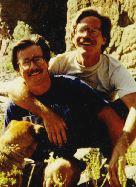
As good as they get
|
If ever we needed a lesson in disease being unjust, Gram was it. If only he'd been a sleaze, if only he'd somehow deserved it. As if anyone deserves it.
Mostly: if only there were a way to make it make sense. But of course it doesn't.
By the time the May issue was published I had changed that first man's name to Adam, not Alan.
- May 4, 1986, to Jane:
I've just come from brunch with Ed Jackson, his lover Sam, Michael Lynch and his lover Sam, Paul Pearce and David Newcome there too. Gram Campbell was also with us, the lover of Alan Miller from the Archives and a man who's always been so genial and nice that he's sometimes hard to believe. But as far as anyone has ever been able to tell, it's all real. Gram was diagnosed with AIDS about a month ago.
The news had numbed TBP's office for a few days: AIDS had never struck that close before, not really. James Fraser had died far away; Don Bell and a few other friends gone by now had not been part of daily life. Gram Campbell was.
- If ever we needed a lesson in the fact that disease is not just, Gram is it: he's about as archetypically "good" a man as one is apt to find.
Gerald sat with me in the typesetting room the day we found out, nearly in tears with rage, saying he knew it was a stupid thing to think but that it just wasn't fair. If only Gram had been a sleaze, if only he'd somehow deserved it, as if anyone deserves it.
Mostly: if only one could find a way to make it make sense. Which, of course, it doesn't. There was nothing here one could fix. It took me a few days to understand, emotionally, not just rationally, that this was not a problem to be solved but a fact to be accommodated, a part of life to be lived with.
Gram's initial bout of pneumonia is past. He came in a few days ago and crept up behind me while I typeset, surprising me with a tickle on the back of the neck. He was in good enough spirits to joke that my article had been good but a little too close to home.
He looked as healthy and beautiful as ever. Only if you know him well can you see that a little of the sparkle is dulled; you can catch him looking a bit pensive sometimes, a handsome and much loved man, 27 years old, almost surely facing death in two or three years.
It would be, as it turned out, three years and eight months.
That brunch marked another sort of demise. The menage at 48 Simpson Avenue had broken up when the house was sold but had been reconstituted, if revised, on Oxford Street in Kensington Market: Eddie, Gerald, Robert Trow and Gerry Oxford had bought a house there, renovated to dazzling designs by Chris Lea.
But now the Oxford Street crew was splitting, too: Ed heading off with Sam Carvelli; Robert to a ghetto high rise, Gerald to another; Gerry to the wonderful coach house behind Roger Spalding's place on Palmerston Boulevard.
Ed and Gerald had lived together almost since they'd first met, 18 years before. Jonathan Katz, on hearing the news, said, "This is the way the Sixties end."
It was no longer gripping, no longer vital -- not just for readers but writers, too, none ever paid, motivated by conviction, not money. Now that conviction was crumbling.
By October we were forced to consider the worst case scenario: bankruptcy. Our accountant said then: "If you were purely a commercial operation, I'd have told you to pack it in quite a while ago. But I know that making money is not why you're here." Heaven knows.
Gerald, who handled the money with some help from volunteers, had been off sick for a while (it was hepatitis; he recovered). In the interim Ken Popert stepped into the breach. Soon his role was formalized, as interim publisher -- the first time this collective operation had ever named any one person to such a position of authority. We needed a firm hand on the tiller. And Ken, if feeling rather stuck with the task, was firm.
But behind the financial problems were deeper ones. The quality of The Body Politic, editorial and visual, had slipped badly. Increasingly ad filled as it had to be to survive, it was no longer the substantial read it long had been. The peak year for features and reviews had been 1979, averaging more than 17 pages per issue; by 1984 it was down to 10, even fewer by now.
Readers were drifting off: local circulation had peaked just after the bath raids at 3,100 copies; now it was 1,800. Sales outside Canada, once a full third of the total, had dropped dramatically. So had another indicator of reader interest: letters to the editor. In 1982 -- only an average year for controversy -- 70 letters had appeared; in 1986, 38. In the January 1987 issue there would be none at all.
It was no longer gripping, no longer vital -- not just for readers but writers, too, none ever paid, motivated by conviction, not money. Now that conviction was crumbling. In September Jane Rule, kept well posted about the mess, had written: "I must admit I've lost interest in The Body Politic, and I'm glad the thinking there is opening up to new possibilities."
We'd spent the summer pondering those possibilities, knowing that the moment when a single medium could be all things to all lesbians and gay men had passed. Already we had Xtra. We dreamed of others: a lesbian tabloid; an international quarterly that might revive the best of TBP's intellectual content; a more popular national monthly that -- we knew -- might supplant The Body Politic itself.
We laboured over a mission statement, our first formal one. It said we wanted to reach many audiences, not just one; not just lesbians and gay men but "those who share their concerns"; those concerns not just homosexuality but "ideas and actions which promote liberating social change, focussing on sexuality in its social, political and cultural contexts."
Grand dreams. But they'd be no more than dreams.
Still, it was remarkable as long as it lived, perhaps the most valuable work any of us had ever done. Or maybe ever would.
Not far away on campus a national meeting of AIDS activists was going on at the same time, old Beepers Ed Jackson and Kevin Orr there and, I felt, my heart there with them. But the 28 of us at Hart House (you'll find us all in a photo at the bottom of this page) soldiered on, hashing out plans to save the paper.
It was all for naught.
- December 16, 1986, to Jane:
I know I won't mail this to you for weeks, a letter not yet even in response to one of your own, but begun now to tell you that, tonight, at a collective meeting, we finally killed The Body Politic. The February issue will be the last one.
The decision was dictated by a desire to survive: Xtra will go on; there will be only three staff; and as much of the office as they can afford will be rented to the Archives and Walker Communications. The operating base will still exist, and there'll be the chance to try something else in the future, a chance I think we risked losing if we'd tried to keep an enfeebled TBP alive. In a way we're lucky to have salvaged anything and, in truth, only time will tell whether we have.
Gerald said that he mourns as much as anything the passing of the constellation of forces that had made it all possible for far longer than anyone could have realistically expected. But that constellation has truly faded, drifted apart. What Gerald mourns for died long before tonight.
Still, it was remarkable for as long as it lived, and I cherish us and every bit of energy we put into giving it that life. It will probably remain the most important thing any of us has ever done.
We had turned to other things: the police; censorship; AIDS.
Roy McMurtry had said it would never happen while he was in office. It hadn't. But now he wasn't. Conservative rule had fractured in the election of May 2, 1985 when the Tories lost their majority. It ended completely on June 18, the Liberals and New Democrats ganging up in a vote of no confidence in the government. In an accord with the NDP, the Liberals took power. In 1987 they'd win a majority of their own.
I'd written Jane on December 4, telling tales of the debates that had heated up the local news.
- Well, as you know by now, it passed. By 19 votes -- more than had been predicted in the quiet before the storm broke. The gallery was full of gay people that evening, and the speaker seemed willing to waive house rules as they applauded and cheered for three minutes.
Of course the next day was much the same; even the "victory party" at Rogues, George's new bar, was a pretty quiet affair.
If people seem unusually calm about the biggest formal victory we've ever won, it only makes sense: we thought we'd lost that battle for good five years ago; neither a Charter of Rights nor a Liberal government in Ontario were dreamt of then. We've all since turned our attention to other things: the police; censorship; AIDS.
The Charter of Rights and Freedoms, enshrined in the constitution of Canada in April 1982, had come into effect in April 1985, governments given three years to brings their laws into accordance with it. Its Section 15 prohibited discrimination based on a list of traditional grounds, race, religion and sex among them. Despite fervent efforts while it was in draft, sexual orientation was not.
But more important than any term in that list were the two words preceding it: "in particular." It was widely expected that courts would take this to mean that the list was not exclusive, that other forms of discrimination could be "read in" and thus prohibited. And that's exactly what happened.
In April 1986 federal justice minister John Crosbie had said his government -- a Tory one -- would "take whatever measures are necessary to ensure that sexual orientation is a prohibited ground of discrimination in relation to all areas of federal jurisdiction."
NDP parliamentarian Svend Robinson (who would come out in time for the 1988 election and still win) said then: "Don't hold your breath!" He was right: changes would take years. But they did come. In 1989 an RCMP officer fired for being gay would challenge his dismissal and win reinstatement. In October 1992 the Canadian Armed Forces would surrender to a Federal Court order forcing an end to their anti gay practices.
Federal human rights law would ban discrimination based on sexual orientation, though that would take more than 10 years from the time of John Crosbie's ringing (if nervous) promise. By then, human rights codes in every province did too, but for Alberta and Prince Edward Island. Even they would later, Alberta forced by the Supreme Court of Canada, which in a 1995 decision unanimously ruled that anti gay-discrimination was unconstitutional.
The Human Rights Decade would last more than a quarter century. But its battles, if not others, were at last won.
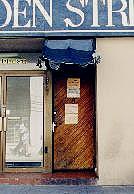
5 Hayden:
|
George Hislop opened the place, as Rogues Western Cruise Bar, in November. It was not his only new venture at the time. Two months earlier he had launched Robert's at 580 Church, in half of a big Second Empire duplex and named for its original tenant, Robert Simpson, founder of the department store chain. It would briefly be Peppermint Park, then revert to Robert's. In 1988, seeking a mixed crowd (it had been mostly men), it would be dubbed Reflections. Then the Dundonald Neighbourhood Pub. Then The Mango. It later went Mexican.
Rogues would go through only one such change, if by force: in June 1988 it was threatened with a suit by a bar of the same name in suburban Mississauga. George launched a contest for a new name. He got more than 1,200 entries, among them: Hang 10 Men; Vidal Saloon; Hog's Breath Inn; Not the Mississauga Rogues -- and Rogues, Dammit. The winner: Rawhide Saloon and Victualizing Parlour. But just as Rogues lost its western tag, so this name would: it got called simply Rawhide.
I was at Rogues (and Rawhide) often enough; any place George Hislop ran could guarantee comfort, if not sure excitement. You could dance; the bartenders were nice; I'd see friends there. On the night of that December party I found myself between two lovers (but not torn; they were former): Brent Ledger and Michael Wade. I enjoyed the juxtaposition.
Also enjoyable were a few quite distinct patrons: male strippers escaping the stage at Fantasies around the corner on Yonge (it was later, or perhaps then but only on some nights, called Heavens), where they usually performed for women. In the early '90s men would be allowed in, but only on Sundays after 9 pm. By then there'd be boys -- less professionally coy and hence much more sexy -- taking their clothes off in other venues. And seven nights a week to boot.
But mostly I could be found at The Barn, still, finding there its distinct wonders. In November I had told Jane of two, both met over my favourite ice breaker there: an electronic trivia game.
- Darryl was at that machine one night: small, 27, hawk faced handsome, mostly deaf. And blessedly undaunted by that last fact. There were always tables at The Parkside where heated arguments were a matter of noiseless, flying hands; one of the busboys at The Barn is deaf, a friend of Darryl's.
There are so many analogies between the historical treatment of deaf people and gay people: fear of the "other"; failure to recognize the validity of unique experiences and contributions (sign, for instance, as a distinct, fully articulated language, not a crude approximation of spoken words); lip reading as a form of "passing" pushed on the deaf by those who thought it better to pass than to let on, by using your own language, that you're "different." Until sign was invented, profoundly deaf people were even thought to be congenitally retarded.
Darryl could speak, well enough to be understood if not with crystal clarity. I took him home. He was another joy, lovely to hold onto, a wonderfully downy bum. And now we're bar friends -- though I'd be a better one if I could sign. It's certainly the most sensible form of communication in a noisy bar, once you get past simple looking.
I'd later work with Deaf people at the AIDS Committee, their independent project housed with us. I'd learn to write "Deaf," capital D, to name not a condition but a culture, rich with its own humour and poetry, distinct and very proud.
A man named Rodney worked there, certainly not disabled even at The Barn, where he had no trouble connecting with attractive men. (Being one himself no doubt helped.) He was nice to me when I tried to communicate with him, but I usually felt stupid doing it. A hearing person who worked with the Deaf Outreach Project said what I felt was justified: Rodney regarded anyone who couldn't sign as illiterate.
But I had attained it. I had basked in it: the thing itself, the person -- suddenly just there, imagine!
Doug Barton, I told Jane, "will not be a boyfriend. Somehow you can tell when that's not in the cards. While I get immense pleasure out of how sexy he is, tall, blond and subtly built, a wonderfully alert face, I don't think I want him to be. He's become a bar friend, which I suppose is to friend as fuck buddy is to lover."
There were lots of men I knew only in The Bar. I did once see Doug outside it, but he would not be a fuck buddy either. It was at his apartment: I'd dropped by on my way to a meeting, when I knew I couldn't stay long. He had no furniture. He'd moved from Victoria just weeks before, got a job waiting at Crispin's.
In that moment, he also had nearly no clothes. On, anyway: he answered the door in nothing but a pair of red nylon running shorts. We sprawled on the floor and yakked. As I said to Jane:
- We talk and talk and I become to myself the person I have always known but in a fresher incarnation: someone I get to see anew and remember I like being. And I relish liking who he seems to be, somebody smart and confident and with a strong sense of humour about himself, though still a little daunted by the change he's made, at 32, in his life. And the view, of course, is fabulous. He wears jeans and running shorts equally well.
What does Doug mean? Nothing more, I guess, than that I can still take joy in people (even off the dance floor!), joy in the simple connection, joy, finally, in being casually and inexplicably liked by someone else.
In late November I ran into Doug at Chaps. He told me he was moving back to Victoria. A few days later he did. I was sad about that but also suddenly enlightened about my reticence with him. It hadn't been entirely sanguine. I went home that night, quite drunk, and wrote this:
- I wish now, knowing the impossibility, that I'd at least sucked his cock. Which always looked wonderful. I liked it when it was noisy in bars with him: in cocking my ear toward his mouth, head down, my eyes were cocked to his crotch. Always this juicy fullness to the left of the bottom button of his 501s. God, I love cocks.
Goodbye, unsucked Doug arms and pecs with tiny nipples I thank god I got to see and long bow legs and delicious boots and armpits and toes and eyes and ski jump nose and anatomically though not at all affectedly pursed lips and crotch loose in red nylon and tight in denim and smooth assflank sliding out from nylon on an empty carpeted floor. It would have been nothing to have you. It's all, in this madly fictionalizing brain, not having you and having you go so neatly.
Goodbye. I'd never have loved you which must be a relief but I loved the fact and prospect of such loose and appetizing affection. We've been bad at inventing the right words; affection is all I've got -- as if lust, lust I knew I'd never fulfill, had nothing to do with it. And -- who knows? Why do we like people? What do we want?
How silly. Goodbye, edible, unhavable unhad Doug.
I would know many more Dougs. As with him -- as with Derek at Chaps; others too -- I usually didn't try anything that might threaten the meaning I took from the moment. Why risk a good thing? To get a better thing? Maybe.
But would it really be better? If Doug was "unhad," I'd had him nonetheless. I know people scornful of beauty once they find it unattainable. But I had attained it. I had basked in it. By then I knew I wasn't finking out, but finding joy in the moment. It wasn't merely "good enough." It was wondrous. The thing itself, the person -- suddenly just there, imagine! -- was a miracle. I went on to Jane:
- I told Gerald some time ago that a lot of my thinking in the last few years has led me into paths that could easily be called religious (a daring thing to say to an adamantly former Catholic).
I don't mean religion in the common sense. But I guess I do mean some innate sense of connectedness with creation -- bad word, since I don't believe it was created, it just happened and we are of it. I imagine that what lies behind spiritual quest if not religious formula is some need to explore what that connection is.
You might be surprised to know that the place I think about all this most is The Barn. I watch people dance and wonder if there is any human society where people don't dance. Or where there is no music. I have no idea. But I imagine music and dance are as human as speech.
Standing by a dance floor watching all that gorgeous movement was, I came to realize, my sacrament. My connection with life's rich wonder and awe.
Someone -- maybe Neil Bartlett; it sounds like him but I can't be sure -- once said: For gay men, cocksucking is a sacrament. I do think it was Neil who said: How could anyone do something so sacred so badly?
Ah well. Maybe their epiphany has yet to come.
See the last big BP (well, PTP) gang below.
Go on to Part Five: 1987-1991 Passion
Go back to: Contents page / My Home Page
This page: http://www.rbebout.com/bar/1986b.htm
December 1999 / Last revised: June 18, 2003
Rick Bébout © 1999-2003 / rick@rbebout.com
